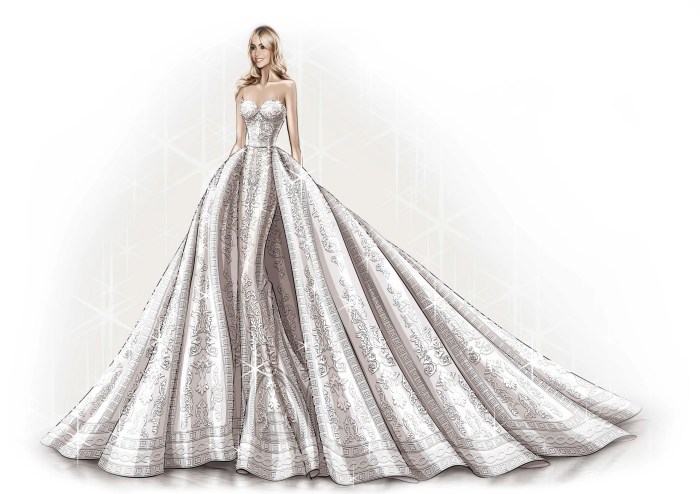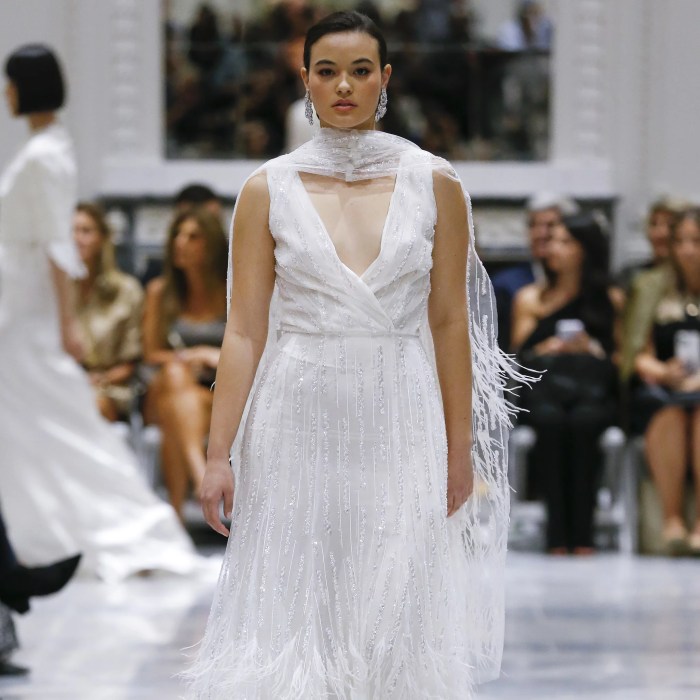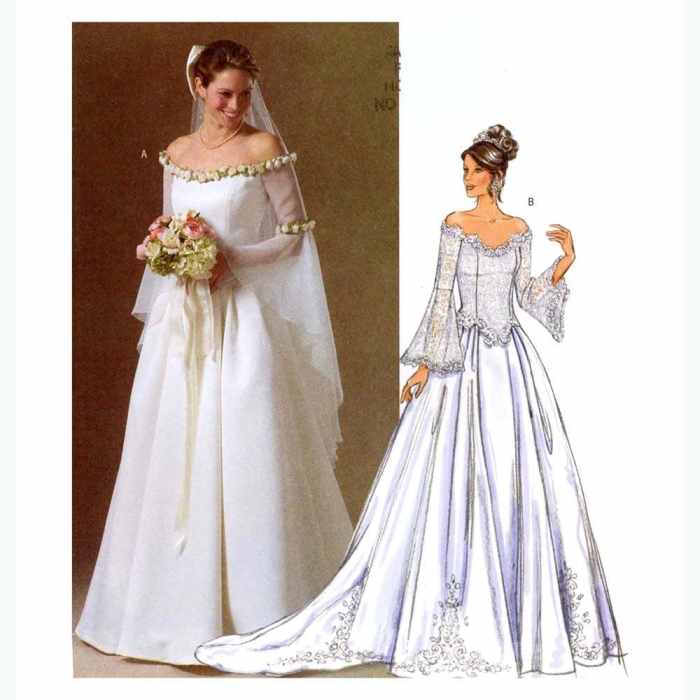Wedding Dress Patterns: A Comprehensive Guide: Dress Patterns For Weddings

Source: vogue.com
Dress patterns for weddings – Choosing the perfect wedding dress is a crucial step in wedding planning. Understanding dress patterns, fabrics, and sewing techniques empowers brides to create or customize a gown that reflects their unique style and body type. This guide explores various aspects of wedding dress patterns, providing valuable insights for both aspiring seamstresses and those seeking a deeper understanding of the process.
Types of Wedding Dress Patterns
Numerous wedding dress patterns cater to diverse styles and body shapes. Understanding these patterns is key to finding the perfect fit and silhouette. The historical evolution of these patterns also offers a fascinating glimpse into fashion’s trajectory.
| Pattern Style | Description | Suitable Body Types | Typical Fabric Choices |
|---|---|---|---|
| A-line | Fitted at the shoulders and gradually widens towards the hem, creating an A-shape. | Most body types; flattering for pear and hourglass figures. | Lace, chiffon, satin, crepe |
| Ballgown | Fitted bodice and a full, voluminous skirt. | Most body types, particularly those with smaller waists. | Taffeta, tulle, organza, silk |
| Mermaid | Fitted from the shoulders to the knees or mid-thigh, then flares out dramatically. | Hourglass, athletic, and pear-shaped figures. | Silk, satin, crepe, lace |
| Sheath | Simple, close-fitting silhouette that follows the body’s natural shape. | Slender body types. | Crepe, satin, jersey |
| Empire Waist | Fitted bodice just below the bust, flowing loosely to the floor. | Most body types, particularly those who want to emphasize the upper body. | Silk, chiffon, georgette |
Historically, the A-line and empire waist styles have seen consistent popularity, reflecting a preference for comfortable and flattering silhouettes. The ballgown style has fluctuated in popularity, often appearing prominently during periods emphasizing romantic and opulent aesthetics. The mermaid style gained traction in the latter half of the 20th century, becoming a symbol of modern elegance.
Choosing the right dress pattern for a wedding can be surprisingly complex, requiring consideration of fabric, silhouette, and overall aesthetic. The process is much like selecting furniture for a home; for instance, finding the perfect balance between comfort and style, as one might when searching for landhausmöbel modern wohnzimmer. Ultimately, the ideal dress pattern, like a well-designed living room, reflects personal taste and creates a lasting impression.
The suitability of a dress pattern depends heavily on the wedding venue. A flowing A-line or empire waist dress might be ideal for a beach wedding, while a more structured ballgown or mermaid silhouette could be perfect for a formal church ceremony. A sheath dress offers versatility, suitable for various settings.
Fabrics and Materials for Wedding Dresses

Source: popsugar-assets.com
Fabric choice significantly impacts the drape, texture, and overall look of a wedding dress. The selection should consider the pattern, season, and personal preference.
- Silk: Luxurious, drapes beautifully, expensive.
- Satin: Smooth, shiny, relatively affordable.
- Chiffon: Lightweight, sheer, delicate.
- Lace: Intricate, adds texture and detail, can be delicate.
- Tulle: Stiff, sheer, often used for volume.
- Organza: Crisp, sheer, holds its shape well.
- Crepe: Drapes well, has a slightly textured surface.
- Taffeta: Crisp, shiny, holds its shape well.
Fabric choice dramatically affects the final appearance. Silk creates a luxurious, flowing look, while lace adds intricate detail and texture. Heavier fabrics like taffeta provide structure and volume, while lighter fabrics like chiffon create a more ethereal feel.
| Fabric | Pattern Suitability | Season Suitability | Pros & Cons |
|---|---|---|---|
| Silk | All | Spring/Summer/Autumn | Pros: Luxurious drape, beautiful sheen. Cons: Expensive, requires careful handling. |
| Lace | A-line, ballgown, mermaid | Spring/Autumn | Pros: Intricate detail, romantic look. Cons: Can be delicate, requires careful cleaning. |
| Chiffon | A-line, empire waist | Spring/Summer | Pros: Lightweight, flowing. Cons: Can be sheer, may require lining. |
| Taffeta | Ballgown | Autumn/Winter | Pros: Holds shape well, creates volume. Cons: Can be stiff, may not drape as well. |
Sewing Techniques for Wedding Dress Patterns

Source: etsystatic.com
Mastering specific sewing techniques ensures a professional finish for a wedding dress. Attention to detail is crucial for achieving a flawless result.
Gathering, pleating, and French seams are essential techniques. Gathering creates fullness, pleating adds texture and structure, and French seams provide a clean, professional finish. Accurate measuring and cutting are paramount for pattern construction. Using sharp shears and following pattern instructions precisely minimizes errors. Pressing seams carefully helps maintain the garment’s shape and overall appearance.
Tips for professional-looking finishes include using a walking foot for even stitching on multiple layers, employing blind hems for invisible finishes, and using high-quality thread that matches the fabric. Precise measuring and careful cutting are essential for accurate pattern construction, minimizing alterations later.
Finding and Adapting Wedding Dress Patterns
Numerous resources provide wedding dress patterns, offering both free and paid options. Adapting existing patterns allows for personalized designs.
Online retailers like Etsy and independent designers offer a wide variety of patterns. Major pattern companies such as Simplicity and Butterick also provide options. Adapting existing patterns involves careful study of the original design, making adjustments to the measurements, and adding or removing design elements. Altering a purchased pattern requires accurate measurements of the wearer, using these measurements to adjust the pattern pieces, and meticulously following the pattern instructions.
To alter a purchased pattern, begin by taking precise body measurements. Compare these measurements to the pattern’s size chart. If adjustments are needed, add or subtract seam allowances as necessary, ensuring the pattern pieces are correctly altered to fit the wearer’s unique shape. Test the altered pattern on a muslin before cutting into the final fabric.
Illustrative Examples of Wedding Dress Patterns, Dress patterns for weddings
Three distinct wedding dress patterns showcase diverse design elements, construction techniques, and fabric choices.
Example 1: Romantic A-line Gown: This dress features a delicate lace bodice with a sweetheart neckline and a flowing chiffon skirt. The silhouette is flattering for most body types, and the lace adds a touch of romance. The skirt’s gentle A-line shape creates a graceful movement. Modifications could include adding sleeves, altering the neckline, or incorporating beading or embroidery.
Example 2: Classic Ballgown: This dress showcases a structured satin bodice with a fitted waist and a full tulle skirt. The silhouette is timeless and elegant, suitable for a formal wedding. The bodice’s clean lines create a sophisticated look, while the full skirt adds drama and volume. Modifications could include changing the neckline, adding a train, or using a different fabric for the skirt.
Example 3: Modern Sheath Dress: This dress features a sleek crepe bodice with a halter neckline and a form-fitting silhouette. The clean lines and modern aesthetic are perfect for a contemporary wedding. The dress’s simplicity allows for various modifications, such as adding sleeves, embellishments, or a unique back detail.
Essential Questionnaire
What is the difference between an A-line and a ballgown wedding dress pattern?
An A-line dress gently flares from the shoulders, flattering most body types. A ballgown features a fitted bodice and a full, voluminous skirt, ideal for creating a dramatic look.
How can I determine my correct size when using a wedding dress pattern?
Accurately measure your bust, waist, and hips, then compare your measurements to the pattern’s size chart. It’s recommended to choose a size based on your largest measurement and make adjustments as needed.
What are some common alterations needed for wedding dress patterns?
Common alterations include adjusting the length, altering the bust or waistline, and adding or removing sleeves or other details. A professional seamstress can provide expert assistance.
Can I use a regular dress pattern for a wedding dress?
While possible, it’s generally recommended to use a pattern specifically designed for wedding dresses, as these often incorporate details and techniques suitable for bridal fabrics and styles.
